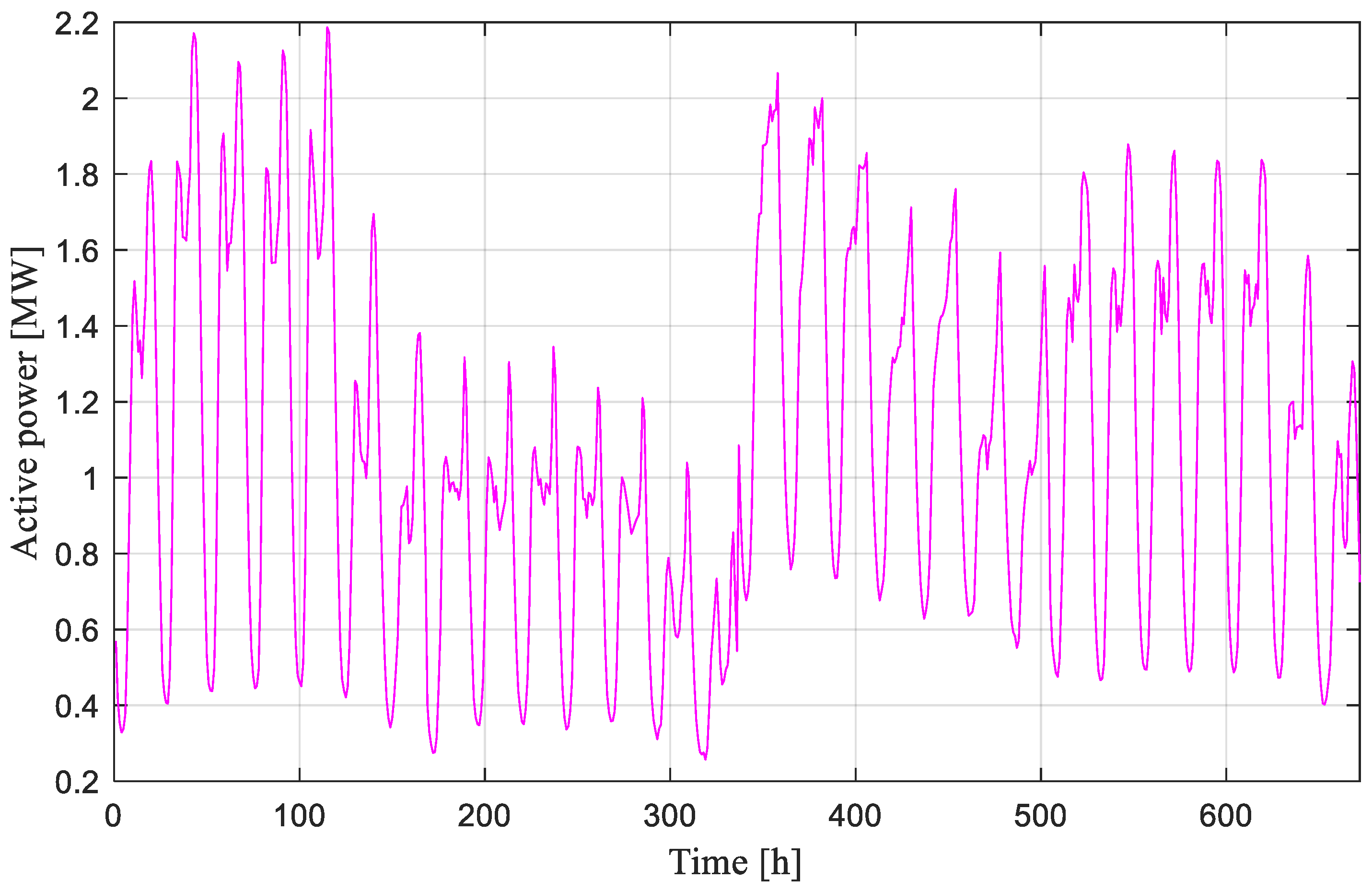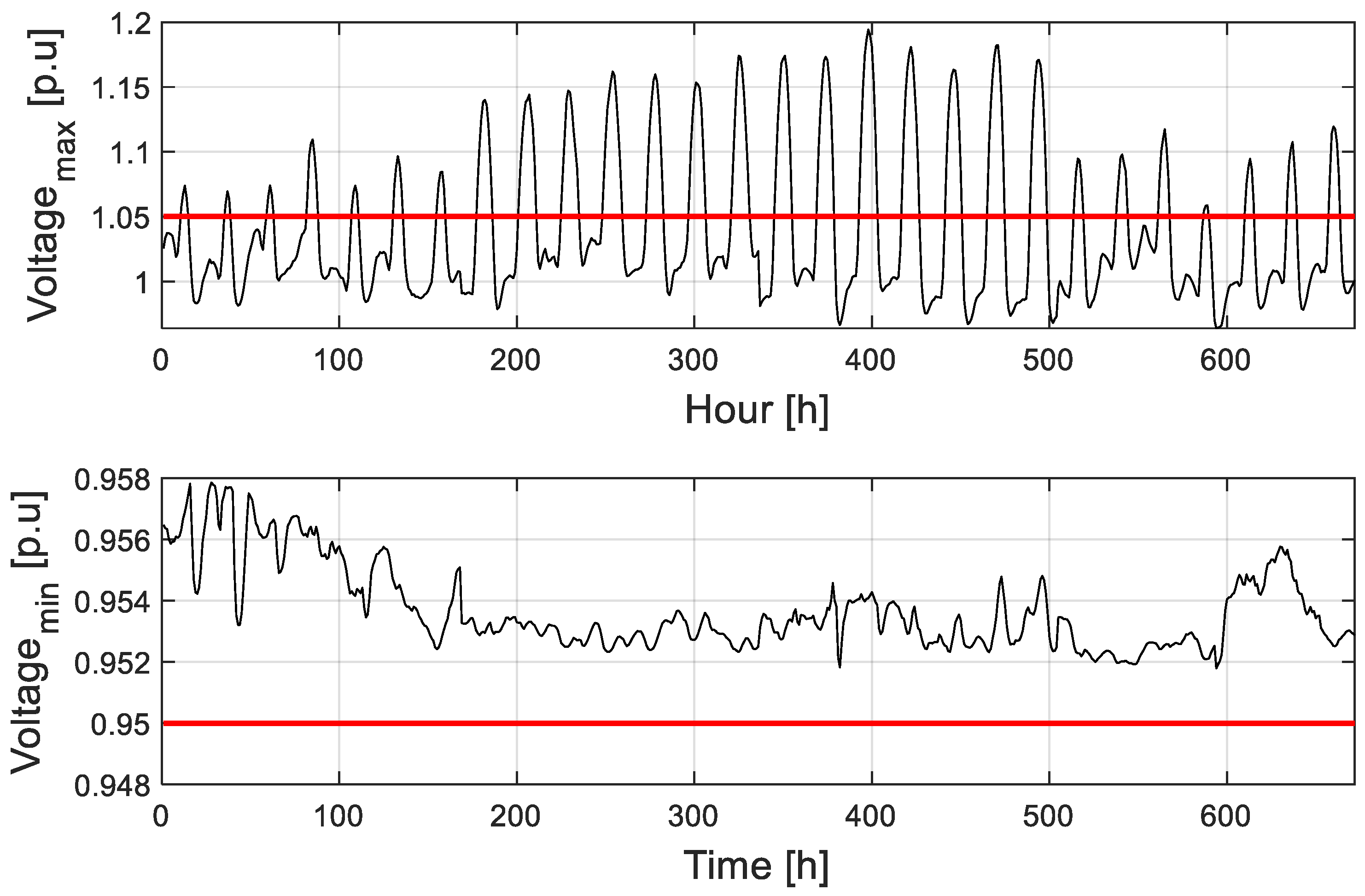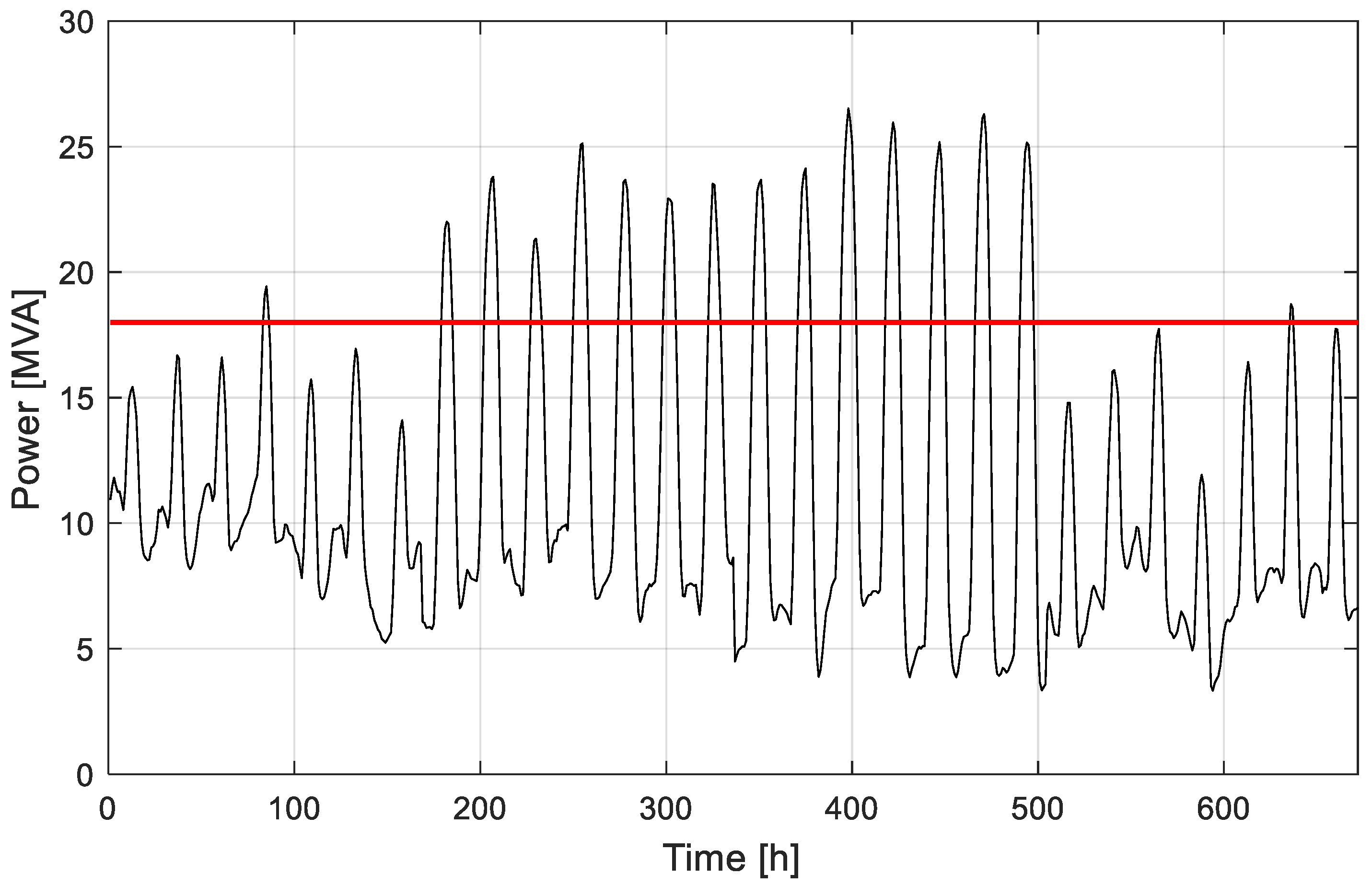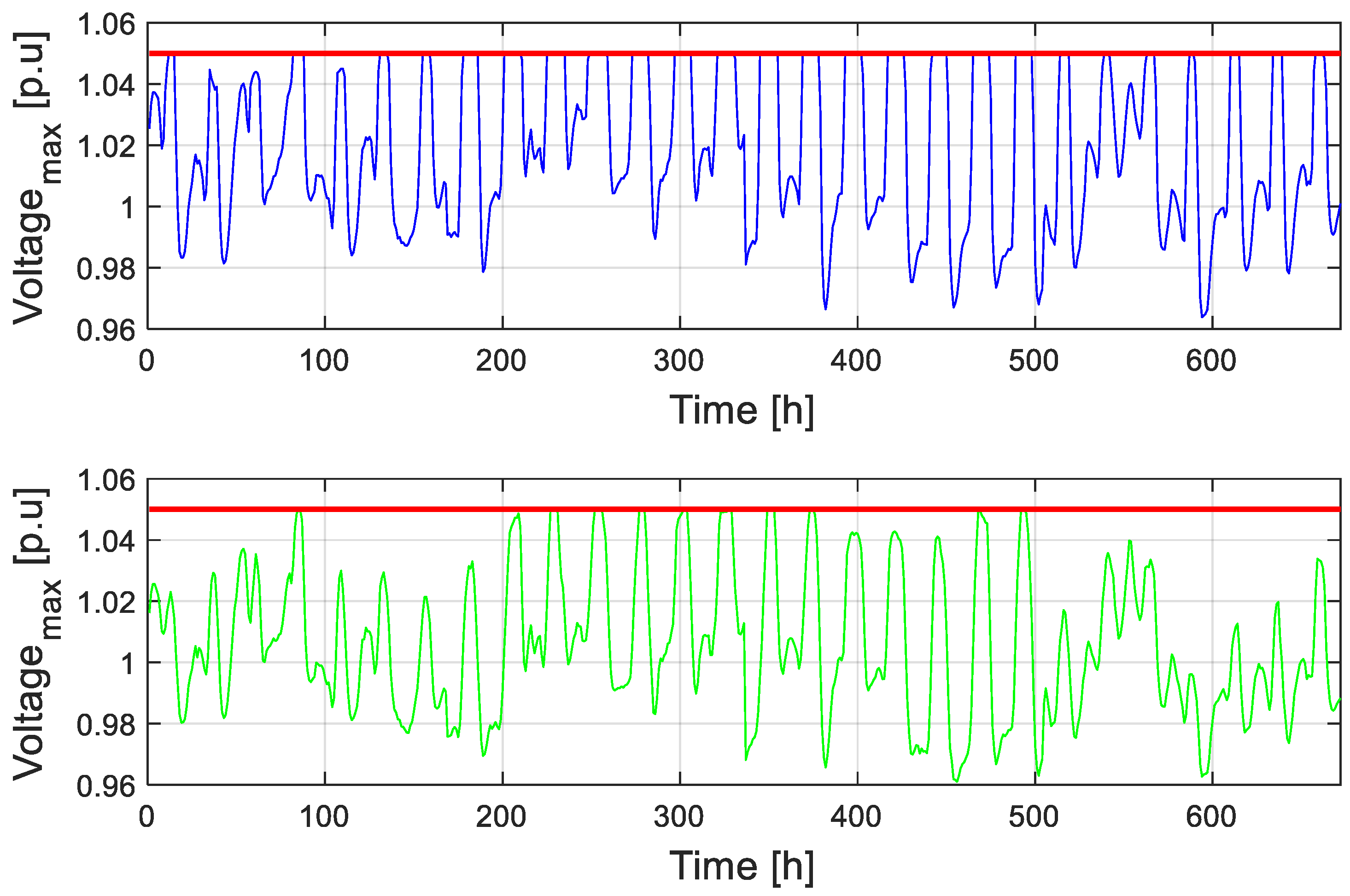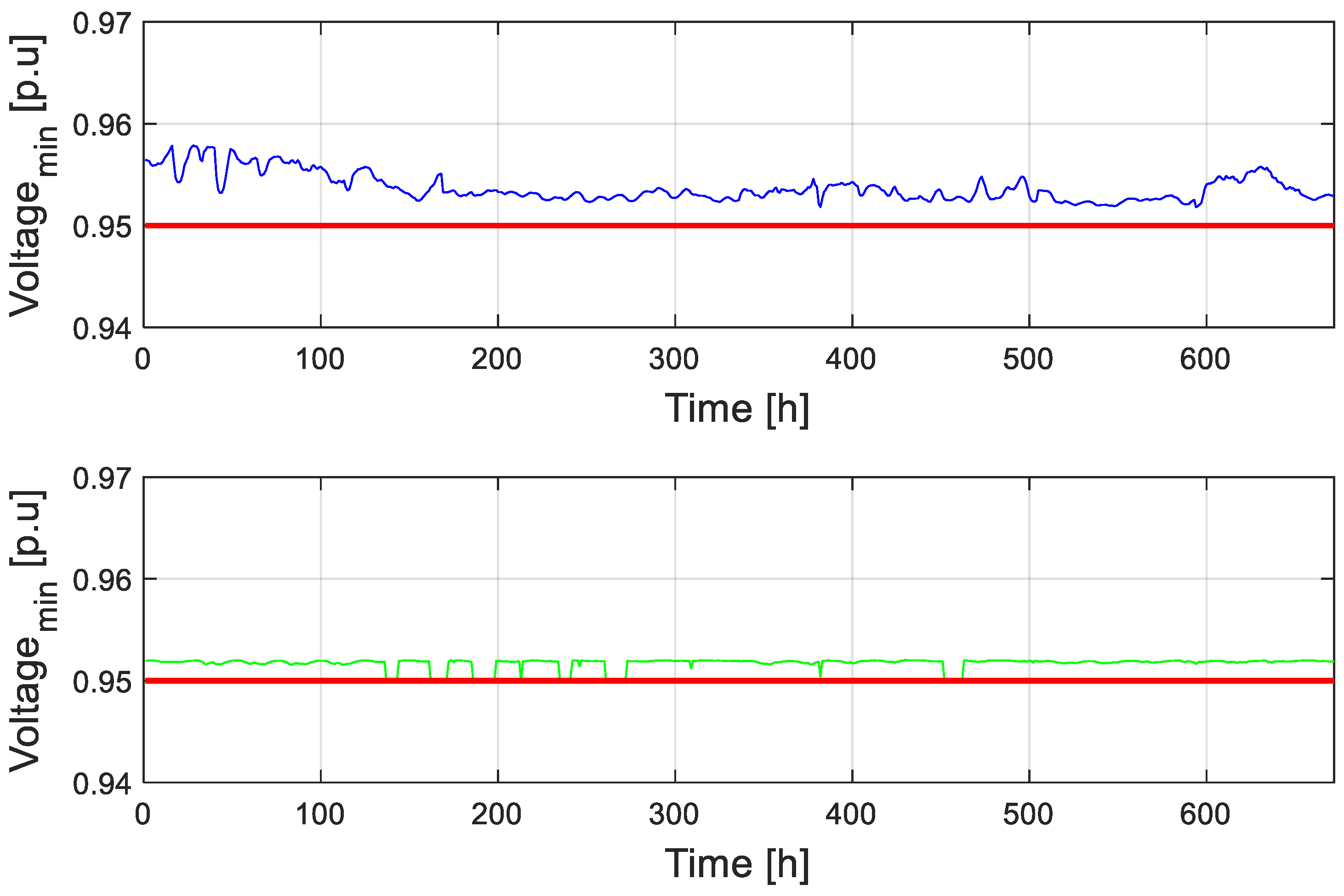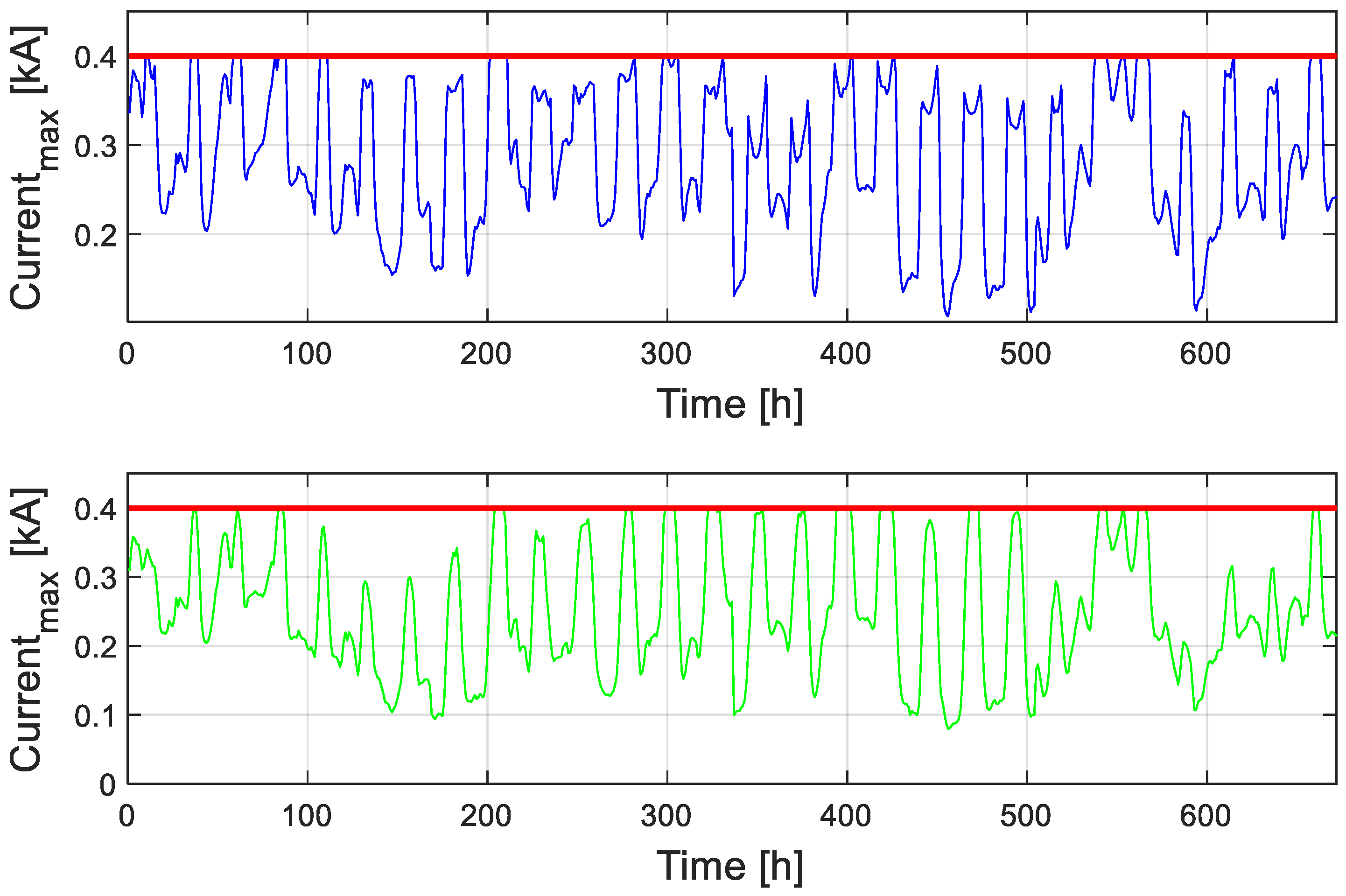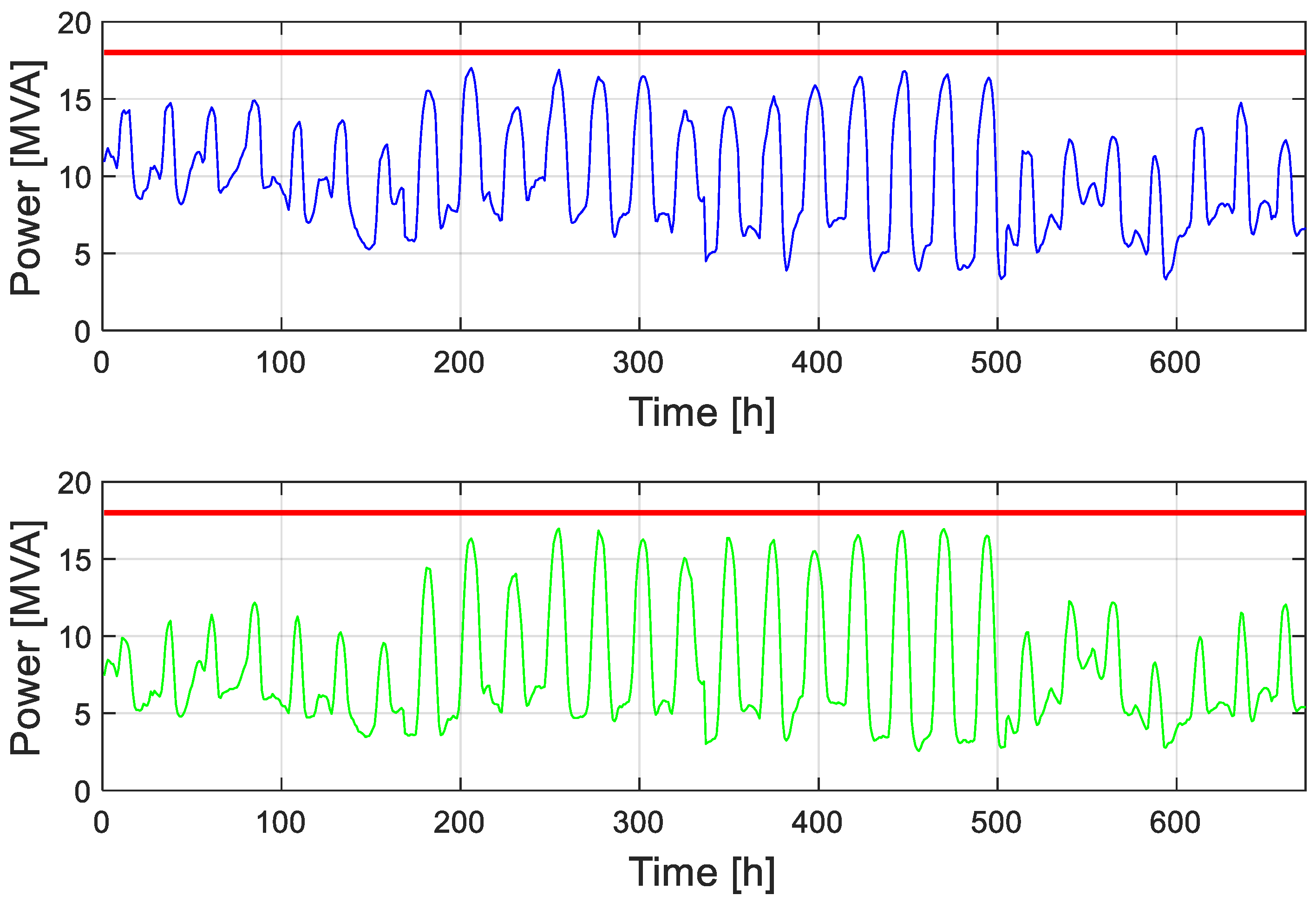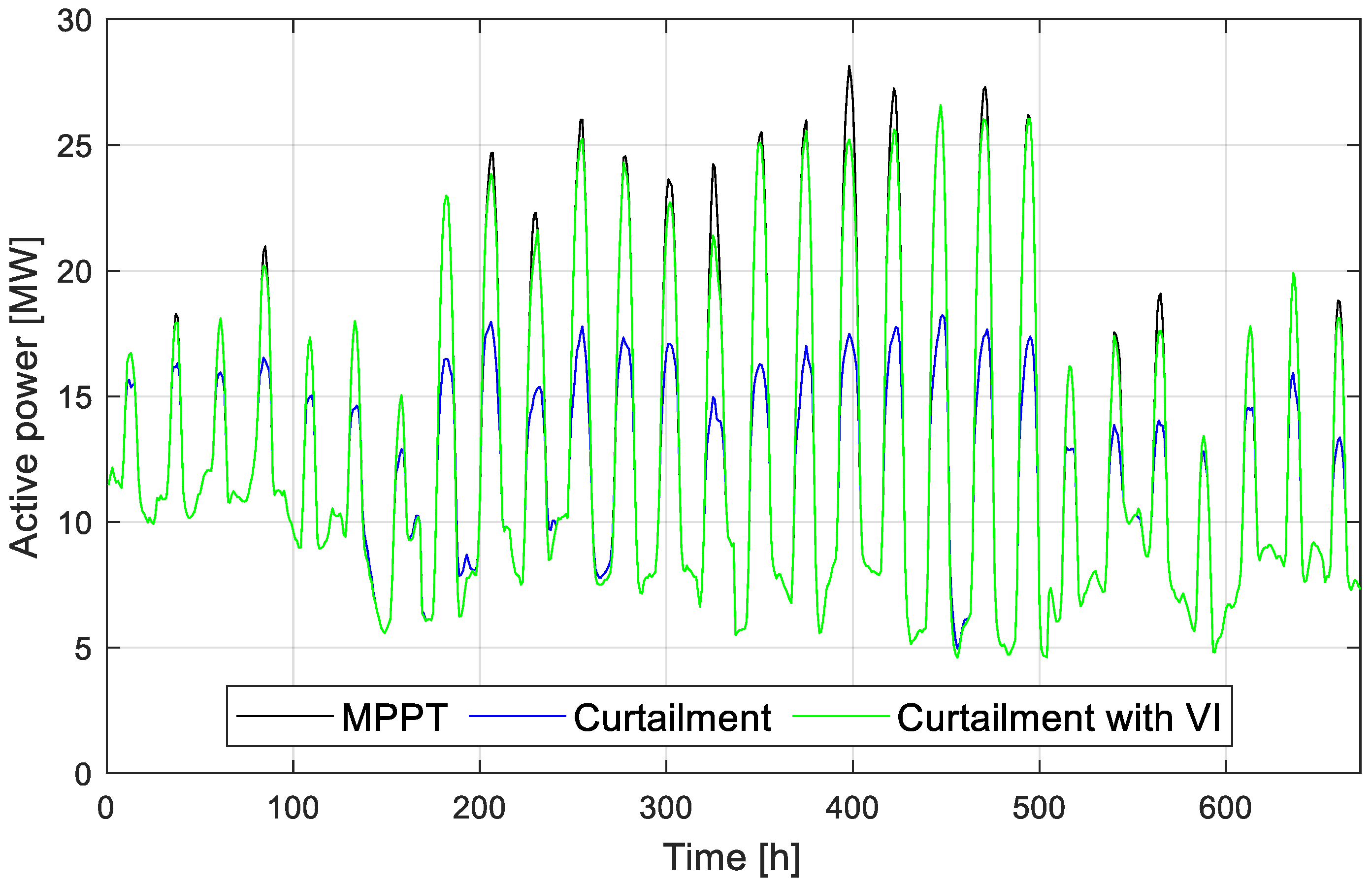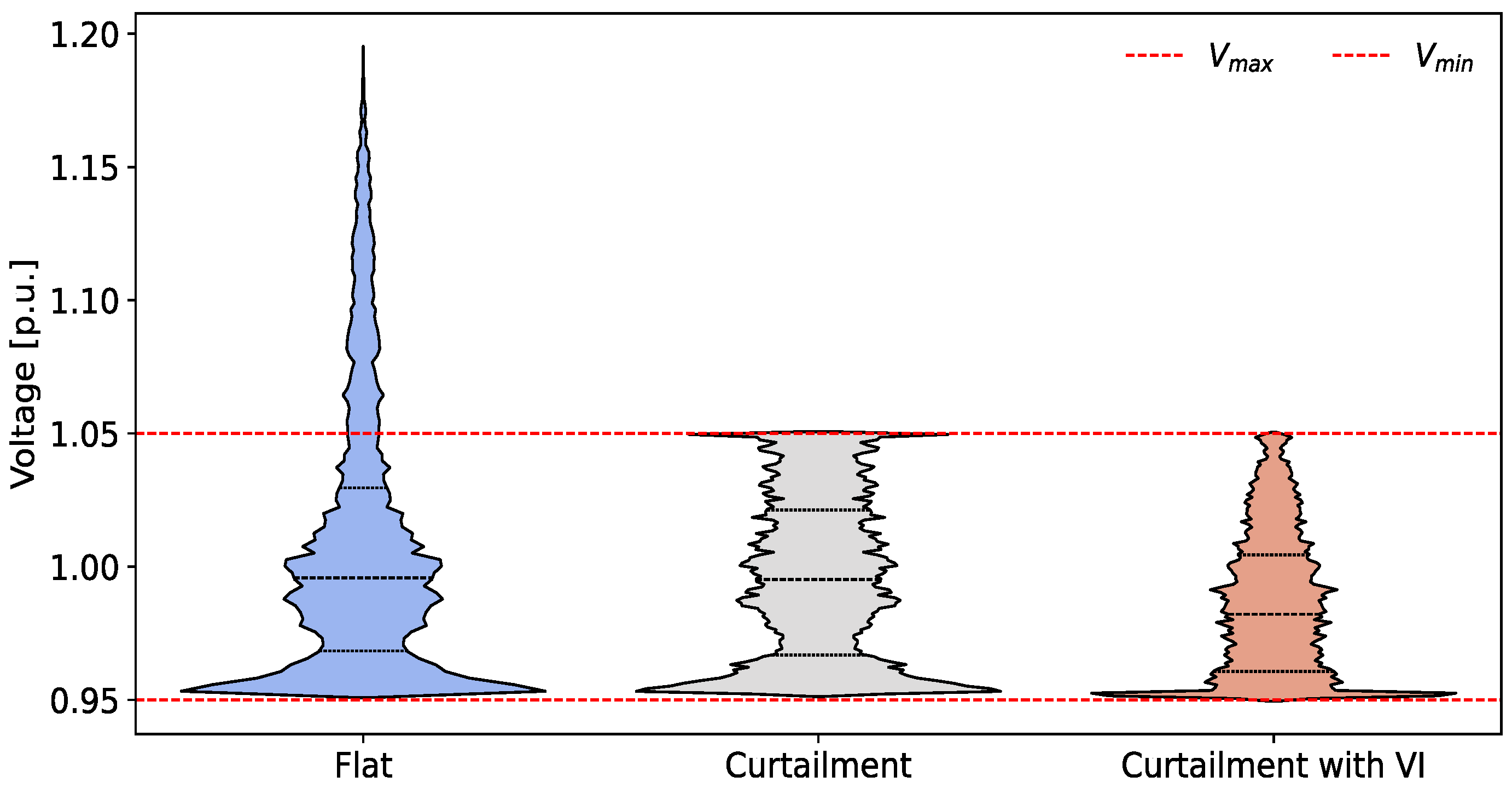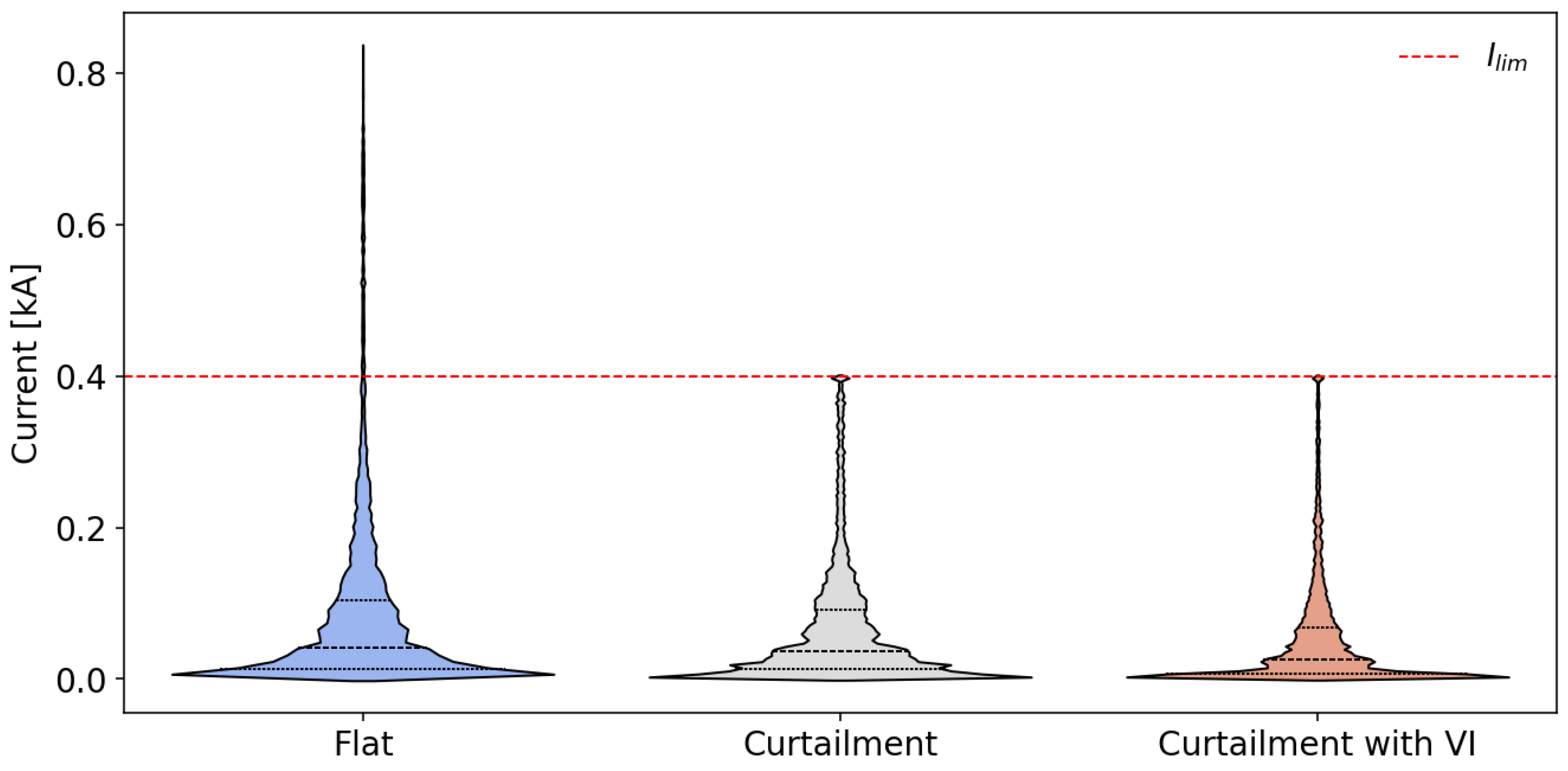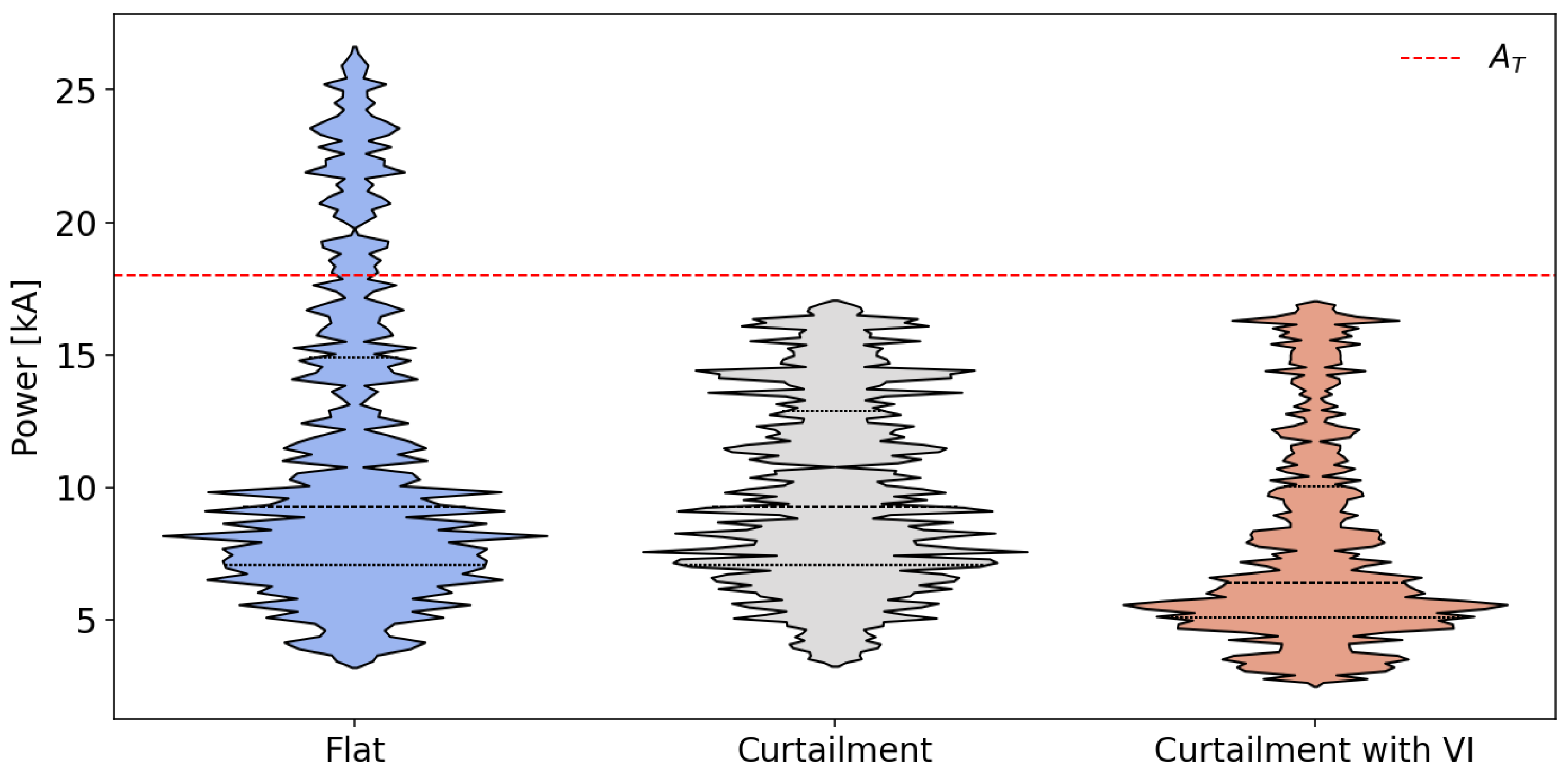1. Introduction
Over the past few decades, the drive towards a sustainable energy future has led to the widespread integration of RESs into modern power grids [
1,
2], introducing technical challenges that require the development of specific measures, such as synthetic inertia, to maintain adequate dynamic stability and ensure secure operation of the transmission grid [
3] and of new flexibility services to prevent RES curtailment and increase the system’s hosting capacity in the distribution networks [
4,
5,
6]. In this context, decentralized flexibility services are gaining increasing recognition as a key enabler for active distribution networks, as they allow local resources to support grid operation, reduce curtailment, and enhance hosting capacity without relying on centralized intervention. Recent approaches, such as the one proposed in [
7], explore decentralized coordination strategies to enhance resilience, highlighting how distributed flexibility can be leveraged as a service to support local energy autonomy and the distribution system.
The sustainable energy transition has been substantially imposed and also supported by European Directives and documents. Among these, the European Directive 2018/2001/EU [
8] discussing the promotion of the use of RESs has introduced energy communities (ECs) to enable energy sharing among different users, fostering environmental, social and technical benefits, making them a valuable asset to face the challenge of a sustainable energy transition [
9,
10,
11,
12].
RECs form a distinct subset of ECs, focusing on RES sharing and maximum exploitation, where the aggregation of heterogeneous types of generating units and loads can create interesting new operational opportunities for the electricity systems [
13,
14].
As an example, RECs can serve as a foundation for new energy-sharing frameworks in buildings [
15], or as a tool for renewable energy deployment in small islands [
16]. Beyond these applications, RECs will significantly influence the operation and management of distribution networks, introducing new paradigms and opportunities for improved grid flexibilization. In this context, the development of digital twin environments, coupled with real-time simulations, is emerging as a powerful methodology to assess RECs’ impact on grid performance [
17,
18]. Moreover, recent advancements in distributed control schemes, such as the control proposed in [
19], offer valuable insights for the development of decentralized flexibility services in active distribution networks.
A notable study on the impact of RECs on the distribution system can be found in [
20], in which a new demand-side management model is proposed in a low-voltage system with multiple RECs. Another interesting example of how RECs can reshape distributions system operations involves the integration of private and public electric vehicle charging stations [
21]. In [
22], a new optimization framework for electric vehicles is proposed in the context of RECs to maximize photovoltaic production exploitation and mitigate electricity demand peaks.
A major study on the interaction between RECs and the power system is provided in [
23], where first, a thorough overview of the regulatory context and European experiences is provided, with a particular focus on the Italian case. The study then addresses various concerns regarding the implementation of RECs, especially with respect to power-related aspects. Finally, the paper introduces a decentralized REC management approach, drawing a parallel with Blockchain technology. This approach aims to distribute benefits among members, while maintaining a decentralized production/consumption system and management and ensuring privacy, and the approach will be further developed and tested.
The authors of [
24] concentrate on improving the control of flexible assets within RECs so that they can operate in a grid-friendly way by reducing the peak power exchange with the grid. Specifically, their study investigates how the impact of the REC varies with the number of participants.
The potential contributions of ECs in supporting the integration of renewable energy into the distribution grid have been explored in [
25], where different control scenarios were analyzed to determine their impact on grid operation. In particular, the study focuses on their ability to mitigate excessive voltage problems in distribution systems that have reached RES hosting capacity, without further grid reinforcement.
In the literature, there are some examples of decentralized control for congestion management in distribution systems. For example, ref. [
26] proposes a gossip algorithm-based approach that is intuitive, robust, and optimally distributes control effort among multiple DERs, allowing the congestion to be cleared. However, it relies on the DSO to provide the exact power to be compensated and only considers active power at the beginning of the feeder, limiting its ability to address intra-feeder congestions.
The multi-agent system (MAS) approach in [
27] operates without a central unit but still depends on congestion management agent (CMA) that gathers user data to calculate cable usage and relay information. Its limitations include the assumption that each CMA (likely at the secondary substation level) has the ability to perfectly observe downstream conditions. Despite its decentralized data flow, the DSO still manages CMAs, and the feeder-based active power control complicates its application under topology changes and network reconfigurations.
The identified research gaps with regard to decentralized control of distributed resources are condensed in the following list:
The approach should autonomously optimize future energy dispatch without central coordination [
26].
It must be able to coordinate energy flexibilities autonomously and decentrally to prevent current-related grid congestion [
26].
It must ensure institutional separation between grid congestion management by the grid operator and energy price negotiation [
23].
The approach must be scalable and remain simple, with a preference for linear methods, efficiently managing computational resources even in large grid systems [
28].
In this context, this paper proposes a novel flexibility service to be provided by RECs called Virtual Islanding (VI) operation [
29]. This approach leverages the autonomy and communication capabilities of RECs to self-regulate in order to solve distribution grid issues in a decentralized way, with reduced intervention from the Distribution System Operator (DSO).
This service is based on the real-time coordination of REC members, achieving an overall self-balance and thereby alleviating grid operating conditions. RECs VI operation draws a parallel with the islanding of microgrids (MGs), a concept that has been extensively studied in recent years [
30,
31,
32]. The benefits of islanded MG operation in distribution systems are well-documented, as evidenced by the significant number of studies on the topic [
33,
34,
35]. However, from a technical perspective, RECs differ from MGs since their participants are scattered across a portion of the distribution grid, making the impact of VI theoretically more effective if properly implemented and managed. Moreover, the VI configuration ensures that all REC participants remain grid-connected, avoiding all the problems associated with islanded operation, such as grid-forming requirements, power supply reliability, protection issues, etc. [
36]. The VI service can be requested by DSOs when critical operational conditions are foreseen. VI is then actuated at the REC level by means of dedicated management features, exploiting the existing communication link among REC members, which is already necessary for assessing shared energy [
36].
VI operation can offer several benefits to the grid; however, one of the main topics of interest in this article is the possibility of improving the sustainability of the power grids by increasing the grid capacity to host RES generation. To this end, this paper proposes an applicative analysis to assess the benefits introduced by VI RECs operation as a flexibility service to maximize the renewable energy exploitation in a medium-voltage distribution system with massive penetration of renewable energy sources. If no other flexibility services are available, curtailing RES generation remains the least efficient solution for coping with grid issues, ultimately reducing the share of RESs exploited in the grid.
With this purpose in mind, the paper proposes a comparative analysis of RES curtailment, both with and without the application of the proposed VI control for RECs, aiming to highlight the positive impact of this novel flexibility service on the sustainability of the power grid.
The paper is organized as follows:
Section 2 provides a detailed description of the proposed REC VI operation concept,
Section 3 describes the development of a tool to evaluate RES curtailment in a generic distribution system capable of also including the proposed VI operation,
Section 4 details the case study used to test the proposed approach, and
Section 5 discusses the related results, followed by some concluding remarks in
Section 6.
2. REC Virtual Islanding Operation
Physical islanding and its detection are broadly studied topics, particularly in the context of MGs, which are defined as a group of interconnected loads and distributed energy resources operating within clearly defined electrical boundaries which act as a single controllable entity with respect to the upstream grid [
37,
38,
39,
40]. In contrast, RECs neither require a single-ownership structure nor necessitate the participation of all end-users within a specific section of the electricity distribution system. This makes the application of physical islanding an unfeasible solution for RECs.
Nevertheless, one may consider coordinating REC participants to achieve a net-zero power balance, effectively implementing VI. This new approach fits well with the structure and purpose of RECs while unlocking new opportunities for these emerging entities to contribute to flexibility services in the electric industry. The concept is partly inspired by the idea of leveraging RECs in a manner similar to a Virtual Power Plant (cVPP). However, unlike a typical VPP, which allows for non-zero net active power exchanges, the primary goal of an REC is to maximize the internal sharing of locally produced renewable energy—an aspect that also underpins its economic value. In this context, VI operation represents the ideal condition for an REC, where renewable generation is fully matched by the community’s consumption.
VI allows the REC to operate in a (quasi) real-time net-zero power balance configuration, self-compensating the fluctuations of stochastic generation and loads, reducing the electricity system’s exposure to unpredictable or volatile operating conditions. Through VI control, active end-users can be reorganized into aggregates that pursue energy neutrality, significantly improving voltage profile, line loading and substation congestion, and ultimately enhancing the share of RES in the power system.
It is evident that, if the DSO could autonomously manage private dispatchable units in the medium- and low-voltage network, the greatest impact on the system operation would be achieved. However, this solution remains largely theoretical, given the complexities involved in its practical implementation. VI operation, on the other hand, offers a practical and feasible trade-off solution: it removes the DSO from the dispatching problem, shifting the responsibility of achieving self-balancing to RECs. From this perspective, the DSO’s role would be limited to requesting the VI operation from RECs, which can provide the best impact on the foreseen grid operational configuration.
In opposition to physical islanding, VI also introduces the possibility of achieving a net-zero balance specifically for active power, while still allowing reactive power to be utilized for other grid-supporting services. This feature is very compelling, as active power represents the revenue-generating component for RECs, which maximize their profits when all renewable energy generated within the REC is covered by its load demand, i.e., the VI configuration may align with REC’s maximum profitability. Of course, if requested by the DSO, VI can also encompass both active and reactive power, opening up the possibility of exploring many flexibility solutions that are beyond the scope of this article.
As far as control strategy is concerned, in the proposed VI approach, the resources within an REC self-regulate their cumulative power injection using data available in the management system of the REC, without any (or with very limited) interaction with the DSO. The proposed method relies on a totally decentralized architecture, from a DSO perspective, and does not make any assumptions regarding the location of the controlled units, while on the REC side, it exploits the community aggregator that, as depicted in
Figure 1, is an existing entity that can exchange information, measure and control requests to the REC members.
The virtual power island is based on pooling resources from different feeders (and potentially even different distribution networks) to self-compensate for power fluctuations. No topological or technical information is assumed. Instead, the availability of a large number of distributed energy resources (DERs) and renewable energy communities (RECs), whose locations were not strategically chosen, guarantees that, as the central limit theorem would suggest, the combined effect of such numerous and independent resources will tend towards a stable average.
The proposed control solves several unresolved gaps in the literature thanks to its simplicity and scalability. Some specific examples are listed below:
The approach is totally decentralized from the DSO perspective; thus, there is no need for coordination between the DSO and the REC.
While operating control, the RECs will still fulfil one of their main goals, which is self-sufficiency.
The coordination of flexible resources inside the REC can be implemented autonomously through the same monitoring architecture used for aggregating the resources and regulating the economic exchanges within the REC [
27].
The approach does not lean on DSO-based load measurement functions [
27].
The approach is perfectly scalable, since it is based on the self-coordination of each REC.
VI can thus represent an important service for integrating a larger share of RESs into the system without affecting the proper operation of the distribution grid.
While the actual design and implementation of the VI is outside of the scope of this paper, the focus of the following methodology is to prove its potential benefits for the grid with the focus on increasing the distribution of the grid-hosting capacity to allow large amounts of RESs. Specifically, the proposed analysis is purely static and does not consider frequency or other dynamic parameters.
3. Methodology
The effectiveness of the proposed VI operation is evaluated based on the increase in the distribution power grid’s hosting capacity. For this evaluation an optimization problem is defined in order to determine the maximum amount of RES production that can be fed into the grid—relative to the maximum available power—while adhering to safe operating grid conditions, including maximum and minimum voltage, maximum current and substation transformer overloading.
The proposed formulation enables the consideration of VI operation by incorporating it as a constraint, which is achieved through the utilization of additional flexibility resources. The improvement in the share of RESs provided by VI operation is quantified by comparing the two optimization problems. In the assessment, four different technologies are considered within the distribution network: photovoltaic plants (PVs), wind power generators (WTs), battery energy storage systems (BESSs), and loads. The developed methodology can be applied to any radial distribution system.
The presented methodology is designed for broad applicability to radial distribution systems and scalability across networks of any size. The scalability of the proposed VI approach stems from its fully decentralized design. Each REC autonomously manages its internal resources to maintain a net-zero power exchange with the grid, relying solely on local data and without requiring knowledge of grid topology or centralized coordination. This structure allows the VI concept to be replicated across multiple RECs, regardless of their size, composition, or location within the distribution network. The approach remains consistent and effective regardless of the number of RECs involved, as each community independently provides the virtual island service, thereby contributing to system-wide flexibility while pursuing its primary goal of energy self-consumption.
Moreover, the introduced approximation ensures a linear formulation, making it suitable for evaluating the benefits of VI in this case, unlike most literature approaches that rely on nonlinear optimization. Additionally, the tool’s generality allows for its application in the analysis of electrical radial distribution networks.
3.1. RES Curtailment Evaluation
In the formulation, a network which includes the primary transformer substation and medium-voltage distribution, downstream of the transformer, is assumed. By this assumption, the methodology can be applied to any radial distribution network characterized by Nn nodes, Nb branches. The selected reference node is the high-voltage node upstream of the transformer, with a constant magnitude equal to vhv expressed in p.u. The j-th branch is characterized by resistance rj and reactance xj. For each branch, the sending (upstream) node is defined as the one closest to the point of connection with the transformer, while the other is defined as the receiving (downstream) node. Transformer branch parameters can be easily derived from the short-circuit voltage vcc% and the xT/rT ratio.
Using
Sb as the base power and
Vb as the base voltage, the injected power at the generic
i-th node can be expressed per unit as
Pi + jQi. The active and reactive power
Pi and
Qi are obtained by combining the active and reactive power of the technologies connected to
i-th node:
where
PPV,i,
PW,i,
PBESS,i, and
PL,i are the active power of the photovoltaic plant, wind park, BESS, and load at node
i, respectively. Similarly,
QPV,i,
QW,i,
QL,i, and
QBESS,i represent the respective reactive powers. In case of one or more missing technologies at node
i, the corresponding active and reactive power are set to zero. The presented methodology is based on the active sign convention. Node voltages and line currents in the optimization problems are modelled based on the assumptions of industrial voltage drop calculations [
41]. The voltage drop across the generic
j-th branch can therefore be calculated as follows:
where
vi is the entry of the (
Nn,1) vector [V] that collects all nodal voltages in p.u., [P] and [Q] are (
Nn,1) vectors whose elements correspond to the active and reactive power
Pi and
Qi at each node i, respectively.
Aji is the
ji-th entry of the network’s nodal incidence matrix (
Nb,
Nn). Finally,
ADji is the entry of the (
Nb,
Nn) matrix that associates each branch
j with all the buses descending from its sending node: row
j is therefore characterized by 1 in the columns corresponding to the descendant nodes of branch
j, and 0 in all other elements. The current of the generic
j-th branch (in p.u.) can thus be derived as follows:
The goal of the optimization problem is to determine the maximum RES power that the system can accommodate while preventing voltage, current, and transformer overloading issues. This can be expressed as follows:
where
PWMPPT,i (
PPVMPPT,i) represents the maximum active power value that the wind (PV) system can provide at node
i according to the Maximum Power Point Tracking (MPPT) technique expressed in p.u. on
Sb base. Additionally,
vmax and
vmin are the maximum and minimum voltage values in p.u.,
Ilim is the current limit in the network lines, expressed in kA,
AT is the transformer rating in MVA, and
Ib is the current based consistent with
Sb and
Vb bases.
The inputs of (5) include the active and reactive power values of loads, the active and reactive power BESSs, the reactive power supplied by the wind and PV systems, and the MPPT active power values. The optimization problem yields the active power produced by the RES, complying with the imposed constraints, from which the amount of renewable power to be curtailed can be derived.
In (5) the time indices of variables and parameters are omitted for the sake of readability; however, the problem needs to be solved for each interval of the considered time frame.
3.2. RES Curtailment Evaluation with VI
The provision of the VI service proposed in this paper concerns the active power of REC members, meaning that community resources are coordinated in real-time operation to achieve a net-zero cumulative active power balance. The investigated solution aligns with REC regulations, which establish that revenues are primarily related to the active power balance.
In this formulation, VI operation is incorporated by introducing an additional constraint on the active power values of REC members. This paper focuses on assessing the impact of VI on distribution system operation; the actual design and implementation of VI control on the REC side are outside the scope of this work and will be addressed in future research. Let
NREC be the number of active RECs, where the generic
k-th REC is characterized by
Nm,k members (either producers, customers or prosumers), VI operation can then be expressed by the following constraint:
where
PRECk,i is the active power associated with the
i-th member of the
k-th REC (following the active power sign convention adopted in the previous formulation).
It is clear that, in order to satisfy the balance in (6) without affecting the RES production, at least one storage system (or dispatchable unit) must be present. By integrating the linear constraint from Equation (6) into (5), a new optimization problem is obtained, whose optimization variables include the active power of the BESSs belonging to each REC, as well as the active power production of the RES. This second optimization aims to reduce RES curtailment by maximizing storage utilization, all while adhering to operational constraints such as transformer ratings, voltage limits, and branch currents, and ensuring a zero active power balance within each REC. With this tool in place, two key applications are possible: determining the required BESS capacity for VI operation or evaluating the VI effectiveness in increasing the share of renewable energy in the grid.
4. Case Study Definition
For the sake of validation, the optimization problems presented in
Section 3.1 and
Section 3.2 are tested on a 33-bus distribution network with multiple ramifications, depicted in
Figure 2, where the presence of three RECs is outlined by using different colours for each REC member; one can refer to
Table 1 for all the grid paraments and data.
The network is characterized by thirty-three nodes (
Nn = 33) and thirty-two branches (
Nb = 32). The voltage level of the considered distribution network is 12.66 kV, while the voltage level of the transmission network is 132 kV. The primary substation transformer is rated with an apparent power
AT of 18 MVA with a 110 kV/12.66 kV ratio, 8% short-circuit voltage and
rT/xT ratio of 1/10. Since most violations are due to overvoltage problems, the transformer tap changer was set to control voltage at its secondary bus to 0.95 p.u., implicitly accounting for the effect of the automatic voltage control system under steady-state conditions, in line with the static nature of the analysis. In order to fit this with the methodology defined in
Section 3, the formulation is adapted considering
v2 as reference bus excluding
v1. The lines of the case-study distribution network are characterized by the parameters reported in
Table 1.
Table 2 lists the technologies present in the distribution network and indicates the nodes to which they are connected. The power factor is assumed to be equal to 0.9 for inductive loads, and 1.0 for RESs and BESSs.
The power consumption profiles of the loads and the MPPT profiles of the RESs for four weeks, representing the four seasons, were sourced from the database [
42], normalized, and scaled according to the sizes of the specific technologies. Reactive power has been considered null for RES technologies, i.e., PV and WT, while for loads, the power factor has been assumed equal to a lag of 0.8. In the context of this study, the assumption of zero reactive power injection is consistent, as the VI methodology relies exclusively on active power balancing and does not depend on the reactive power behaviour of the units. Furthermore, the analysis aligns with current Italian regulations, which do not impose reactive power or voltage support requirements on small-scale generation plants, or, consequently, on RECs.
For the sake of readability, individual power profiles are omitted; instead,
Figure 3 and
Figure 4 report the aggregated profiles per technology (i.e., load, PV and wind) where one can see the relevant amount of RESs included in the test case grid. Detailed time profiles for each technology at each bus are available in the Supplementary Material for the interested reader [
42].
Specifically, the analysis spans a four-week period, with a suitable profile for each week to capture the power behaviour across different seasons. The time-step used is 1 h, resulting in a total of 672 points. To test the VI service, the presence of three RECs is considered: the first REC consists of the load at node 12, the BESS at node 15, the PV at node 16, and the WT at node 25, marked with yellow dots; the second REC includes the BESS at node 21, the WT at node 22, the load at node 26, and the load at node 30 marked with blue dots; and the third REC is defined by the load at node 29, the BESS at node 31, and the PV at node 32 marked with green dots.
The selected test case scenario is intentionally configured with a massive penetration of RESs to align with the goals of a sustainable energy transition. Additionally, the reactive power of inverter-based technologies (RESs and BESSs) is set to zero in this analysis, as the focus is on assessing the impact of a net-zero active power balance. Potential services involving reactive power will be explored in future research. Therefore, only the loads are considered to have non-zero reactive power.
Building on this network asset, three distinct scenarios are examined:
The Flat Scenario: all RES production is fed into the grid with assigned PV, WT and load profiles. The flat scenario aims to showcase the technical issues the grid shall face if no action is taken by the DSO. Only load flow analysis is conducted to evaluate grid parameters, such as voltage, current, and transformer loading.
The RES Curtailment Scenario demonstrates the potential mitigation introduced by curtailing RES, which is currently the only method available to address such issues. The total amount of renewable energy the DSO should curtail to cope with the technical limitations is evaluated. For this scenario, the optimization problem described in (5) is solved.
The RES Curtailment with VI Scenario evaluates the impact of VI in reducing RES curtailment, while still managing the system technical constraints.
BESSs are assumed to be decisional variables only in the third scenario, where they will be used to actively manage the REC. In the first two scenarios, the BESSs are not treated as decisional variables and instead follow the needs of the specific owners.
5. Simulations and Results
The described distribution grid has been characterized by a relevant amount of RESs to show how the VI tool can contribute to improving the power distribution grid’s capacity to host RESs compared a specific centralized distribution network Curtailment scenario.
As previously mentioned, in the Flat scenario and Curtailment scenario, the BESSs’ production and absorption are set to zero for simplicity. However, any other power profile unrelated to the optimization problem can be used without any loss of generality. As demonstrated in [
43], the use of the linear model for calculating node voltages and line currents in distribution networks is acceptable, as it provides results that are consistent with those obtained from the nonlinear power flow calculations. Specifically, the resulting error is deemed acceptable for the purpose of this study, which is to assess the impact and benefits of the VI service on the hosting capacity of a distribution network.
Considering the voltage limits
vmax and
vmin equal to 1.05 p.u. and 0.95 p.u. and the current limit
Ilim equal to 400 A, the Flat scenario is characterized by a total of 3938 overvoltage violations, 556 current limit violations, and 109 violations concerning the transformer overload in the primary substation. In general, within a 274 h period, at least one violation is recorded, representing 40% of the time considered. In the Flat scenario, electrical quantities appearing in the constraints of the proposed optimization problems are calculated simply to highlight network violations if no action is taken.
Figure 5 shows the maximum (minimum) voltage value in the grid for each hour, highlighting
vmax and
vmin thresholds in red. One can notice overvoltage problems during 216 central hours of the days across the four analyzed weeks. Similarly,
Figure 6 reports the maximum current value for each hour, highlighting that, during these hours, at least one line experiences overcurrent issues, meaning that the current exceeds the limit of 400 A (as indicated by the horizontal red line).
The line current profile shows that, in 209 h, at least one line experiences overcurrent issues, meaning that the current exceeds the limit of 400 A (horizontal red line). It should be noted that the profiles of the maximum (minimum) quantities displayed do not pertain to a specific network element, node, or line, but correspond to the network element that is characterized by the maximum (minimum) value in the analyzed hour.
Figure 7 illustrates the apparent power flowing into the transformer, with the transformer rating represented by a red horizontal line. It is possible to notice how the transformer rating limit is exceeded for 109 h, indicating that, without intervention, either curtailment or a transformer revamp shall be considered.
Starting from this complex and critical configuration, the comparison with the grid operation if RES curtailment if considered is proposed below, alongside an introduction of the proposed VI operation of RECs.
Figure 8 and
Figure 9 show the voltage of the bus with the maximum (minimum) voltage value for each hour, providing a comparison between the RES Curtailment scenario and the Curtailment with VI scenario. As one can see, RES curtailment provides a solution to the problem of voltages reaching values very close to the considered operational limits. On the other hand, VI operation has a more effective impact on the system voltages.
Figure 10 reports the maximum current value present in the network for both the RES curtailment scenario with and without RECs VI. From this figure, one can see that both approaches can provide a suitable containment of line currents within the considered thermal rating.
Finally,
Figure 11 reports the primary substation transformer’s apparent power in the two scenarios with and without VI operation.
Overall, both optimization problems successfully address the issues posed by the significant amount of RESs, as no violations occur in either case. Nevertheless, it is crucial to quantify the amount of RES power curtailed to achieve the desired configuration in the Curtailment scenario and compare it with the VI scenario. For this purpose,
Figure 12 reports the RES profiles for the three considered scenarios. Based on these profiles, one can assess that the RES Curtailment scenario only exploits a share equal to 82% of the available RES energy, while the introduction of the proposed VI operation empowered by RECs increases this share up to 99%, allowing an almost complete exploitation of the installed RES’s energy. Specifically, the VI strategy significantly reduces renewable energy curtailment—from 18% to 1%—by enabling decentralized active power balancing, thereby increasing local self-consumption and enhancing the overall economic benefits for both prosumers and the REC.
This is quite a remarkable result, since VI control neither requires nor implies any flexibility in the management of resources from the DSO; at best, it facilitates exploitation of the use of power grid prosumers’ flexibility. Finally, the power profiles of BESSs in RECs are reported in
Figure 13. The amount of BESS-installed power is reasonable if compared with the total amount of RES present in the considered system. The BESS ration of installed RESs is roughly 40%, which is a reasonable ratio for state-of-the-art installations.
For a better visualization of the impact of the proposed VI operation,
Figure 14,
Figure 15 and
Figure 16 showcase a violin plot illustrating the voltage, line current, and transformer loading distribution throughout the entire simulation period for the three simulated testcases. The plot also displays the median and quartiles, providing a comprehensive view of the data distribution.
Overvoltage violation and transforms violations were the most frequently occurring violations in the Flat scenario, while overcurrent problems were less frequent but were characterized by a 200% overloading peak. Clearly, violations are solved for both the RES curtailment scenarios but, generally, VI operation provides a more effective grid alleviation, avoiding the presence of a large concentration of operational points placed on the border of the considered operational range. This allows us to conclude that VI can represent a very interesting opportunity to increase the flexibility of the grid and its capacity to host larger numbers of RESs in a decentralized and effective manner.
6. Conclusions
This paper proposes a novel flexibility service for RECs, referred to as Virtual Islanding, to improve the resilience and sustainability of the distribution electricity system. VI allows us to better harness the energy potential of RECs and coordinate their resources to achieve a virtual net-zero exchange with the distribution grid. This control alleviates the distribution infrastructure, mitigates congestion, and increases the grid’s capacity to host RESs without violating technical operating constraints. The effectiveness of the proposed approach has been demonstrated through the development and testing of an optimization operational tool in which VI can be incorporated as a constraint for all RECs connected to the same primary substation. Compared to typical MG islanding, VI offers the advantage of being applicable to both active and/or reactive power, while ensuring that REC members remain connected to the main grid, thereby avoiding the issues of islanded operation. The evaluation of the benefits of the proposed REC VI was assessed on a 33-node test system with multiple RECs. In both cases, it highlighted the benefits both in terms of improved RES energy exploitation and of the mitigation of grid operational issues, such as voltage profiles, line congestion, and substation transformer overloading.
In the light of the positive results achieved, future developments will focus on the actual design of the VI controller at the REC level, studying the strategies needed to help the REC VI control find a suitable configuration to actually deploy the demonstrated grid benefits. The control scheme will rely on a two-level architecture, consisting of higher-level optimization based on forecasts and real-time measurements, and a fast-response level to compensate for residual deviations. Such an architecture builds upon the communication and measurement infrastructure already required for energy sharing and remuneration, thereby minimizing the need for additional investments. Moreover, the use of standard and lightweight communication protocols (such as Modbus TCP/IP or MQTT), along with privately owned measurement systems, further enhances the feasibility of the VI service.



